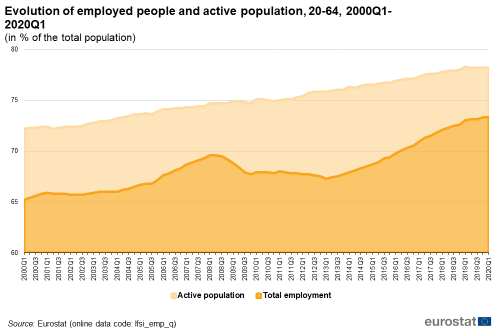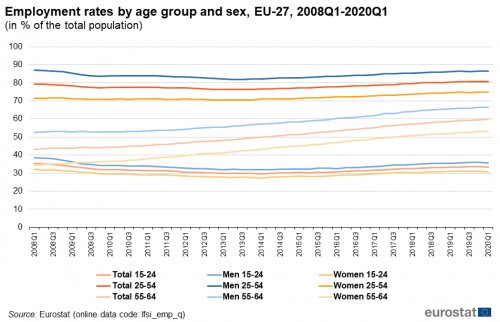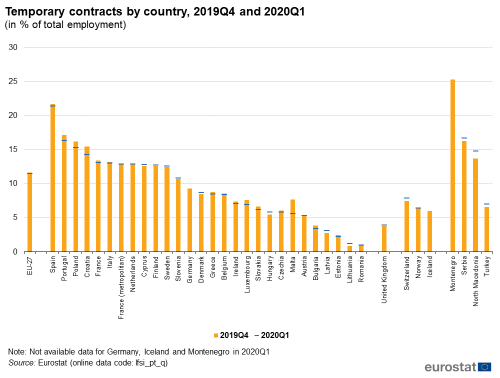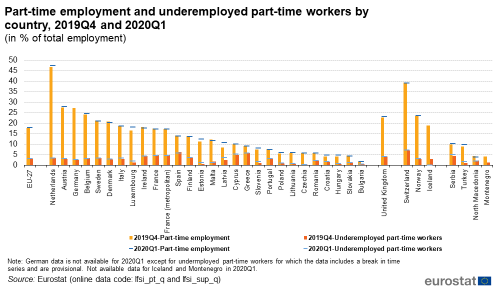Archive:Employment in detail - quarterly statistics
Data extracted in August 2020
Planned article update: October 2020
Highlights
The COVID-19 pandemic generated pessimistic forecasts in economic results through the European Union. In most EU Member States, businesses as well as public sector have been shaken by worldwide shock waves due to the lock-down and other health related measures. Containment measures have been settled down like extended short-time work schemes and guaranteed loans in order to dampen the impact on employment, this allowed keeping employees and self-employed attached to their jobs in the first stage of the crisis. However, even if mass dismissals could have been constrained in a first time, hiring might have been directly affected by the pessimistic expectations: enterprises ready to effectively recruit could have withdraw their vacancies, reconsider its plans or put off the recruitment process. Other people like people in probationary periods or trainees might have, in normal times, integrated employment in a longer term but instead, experienced a job loss due to the COVID-19 downturn. These can be among others mechanisms what can be anticipated in a very short term as regards employment. Forward, enterprises might encounter long-term difficulties due to change in the the economic activity and lay off in a larger extent. The sanitary crisis emphasizes also a slowdown already begun in the previous quarters in 2019.
This article focuses on the changes in the employment observed along the economic crisis based on the quarterly data from the Labour Force Survey . It aims at showing the last and long term developments essentially at the European level of the employment in general but also specifically for young, mid-age and older people as well as for men and women. Specific point is dedicated to the evolution of temporary contracts and part-time including underemployed part-time workers. Detailed analysis on the activity sector, the level of education and the professional status by EU Member States complements this article.
Note: This article uses the seasonal adjusted data from the first quarter of 2020, i.e. January-March 2020, which is compared in some sections to the last quarter of 2019. It is expected that the consequences of the COVID-19 crisis on the labour market will be more visible in the second quarter of 2020 (April-June 2020) given the COVID-19 measures taken in many countries.
Full article
Halt in the employment growth in the EU-27
Employment rate stopped growing beginning of 2020, for the second time since 2013
Since 2013, in the European Union, the share of employed people in the total population kept on growing from a quarter to another until the third quarter of 2019, in which it remained stable compared to the previous quarter for the first time in 6 years. From the third to the fourth quarter 2019, the employment rate increased again from 73.1 % to 73.3 %. However, from the last quarter of 2019 (i.e. 2019Q4) to the first quarter of 2020 (2020Q1), the share of people in employment remained at the same level, recording the second flat growth since 2013 (see Figure 1). Employment of men and women also showed steady shares in the total population between 2019Q4 and 2020Q1: 79.1 of the male population is employed while it is the case 67.5 % of the women. The active population has been exactly unchanged over the last four quarters accounting for 78.2 % of the total population.

(in % of the total population)
Source: Eurostat (lfsi_emp_q)
In the first quarter of 2020, the last data available, 73.3 % of people aged 20-64 was employed. This is the record high since the first quarter of 2000, the starting point of the time series. In terms of comparison, in 2000Q1, less than two thirds of the total population between 20-64 was in employment (65.4 % ). The increase over this last 20 years is mainly explained by the substantial and steady growth of employment of senior people, increasing from 34.7 % in 2000Q1 to 59.7 % in 2020Q1 as it can be easily observed if Figure 2.

(in % of the total population)
Source: Eurostat (lfsi_emp_q)
Subdued change in the employment rates in the vast majority of EU Member states
Among EU Member States, more than 80 % of the population aged between 20-64 is employed in Sweden (81.7 %), Estonia (80.7 %), the Netherlands (80.6 %), Germany (80.4 %) and Czechia (80.3 %) in the first quarter of 2020. The lowest employment rates were reported in Greece, Italy, Croatia, Spain and Belgium where seven or less persons out of 10 were employed at the same period (61.7 % in Greece, 63.6 % in Italy, 67.1 % in Croatia, 67.9 % in Spain and 70.4 % in Belgium).
As at the European level, the share of employed people in the total population in 2020Q1 remained to a certain extent the same in most of the Member States compared to the previous quarter. However, the employment rates in Malta and Luxembourg fluctuated by more than 0.5 p.p. between both quarters (+1.6 in Malta and -1.9 in Luxembourg). Estonia, Portugal and Bulgaria registered an decrease of 0.5 p.p. in the share of employed people in the total population, reaching respectively 80.7 %, 75.8 % and 74.5 % while Romania registered an increase of 0.5 p.p. of the employment rate where 72.1 % of the population were employed in the first quarter 2020.

(in % of the total population)
Source: Eurostat (lfsi_emp_q)

(in percentage points)
Source: Eurostat (lfsi_emp_q)
Looking at the specific employment rates of men and women by country in Figure 4, in almost all countries, there is no clear pattern in the evolution of the employment rates. In 23 out of 27 Member States, men and women are quite close in the evolution of the employment rates very often the difference of variation is at most 0.5 p.p. and not systematically in favour of men or women. In four countries, namely Sweden, Estonia, Malta and Croatia, the change in the employment rates for men and women is nevertheless more disparate. In Sweden and Croatia, the share of employed men in the male population held at 84.3 % and at 72.1 % while the share of employed women decreased from 79.7 % to 78.9 % (-0.8 p.p.) in Sweden and from 62.7 % to 62.1 % (-0.6 p.p.) in Croatia. In Malta, the female employment rate increased by 3.1 p.p. to 69.4 % in 2020Q1 while the male rate increased by 0.1 p.p. Finally, in Estonia, the male employment decreased by 1.1 p.p., standing for 83.3 % in 2020Q1 and the female varied by 0.1 p.p.
Young people less employed
Since the first quarter 2015 until the third quarter 2019, employment of young people (aged 15-24) increased continuously from a quarter to another. Between 2019Q3 and 2019Q4, it remained stable around 33.6 % and decreased to 33.3 % in the first quarter 2020. It decreased by 0.3 p.p. for men reaching 35.6 % and by 0.4 p.p. for employed women who stood for 30.7 % of the total female population in 2020Q1 (see Figure 5).

(in % of the total population)
Source: Eurostat (lfsi_emp_q)
Among mid-age people i.e. people aged between 25 and 54, 80.7 % was employed in the 2020Q1 against 80.8 % in 2019Q4. For the first time since 2012Q4, although slight, the employment rate recorded a decrease from a quarter to another. Men held at 86.5 % between both quarters while women lost 0.1 p.p. and stood for 74.9 % in the first quarter 2020.
Overs the 10 years between 2009Q2 and 2019Q2, the sustained growth at the EU level of the share of employed people aged 55-64 was visible from a quarter to another. This increase of the share of workers aged 55-64 is partially explained because this category has been maintained in employment longer, effective retirement age has been raised in many countries in the two last decades. However, in 2019, the growth of employment rate of people aged 55-64 has been flat from the second to the third quarter whereas it was common to record growth from 0.3 to 0.5 p.p. from a quarter to another since many years. From 2019Q4 to 2020Q1, the share of employed people 55-64 increased by 0.1 p.p. reaching 59.7 % of employed people in the total population, share of employed men registered an increase by 0.2 p.p. in 2020Q1 standing for exactly two thirds of the male population between 55-64 (66.6 %) while the female employment rate increased by 0.1 p.p. standing for 53.2 %. This age category might potentially be less affected in the very short-term than young people by the halt in recruiting during the lock-down but might be in medium term more fragile against mass dismissals.
Less temporary contracts, part-time employment unchanged
Confirmed downward trend in temporary contracts
In 2020Q1, slightly more than one out of 10 employed persons in the EU-27 were employed under temporary contracts (11.5 %). From 2013Q1 to 2017Q2, temporary contracts had a slight positive trend reaching, 23,301 thousand of persons which accounted for 12.5% of the total employment in 2017Q2. After three consecutive quarters recording quite flat evolution, the share of temporary contracts somewhat went down from 2018Q2 to 2020Q1 and got back to the level registered beginning of 2013 i.e. 11.5 % which corresponds to 22,045 thousand persons (see Figure 6).

(in thousand persons)
Source: Eurostat (lfsi_pt_q)
Among EU Member States, except Germany for which data is not available, 17 out of 26 EU countries registered a decrease in the share of temporary contracts in the total employment between the last quarter 2019 and the first quarter 2020. At European level, it decreased by 0.2 p.p. In Malta, Croatia, Poland, Portugal and Luxembourg, the percentage of temporary contracts in total employment decreased by more than 0.5p;p. between both quarters (-2.1 p.p., -1.2 p.p., Poland and Portugal -0.9 p.p. and Luxembourg (-0.7 p.p.). Spain, Portugal, Poland and Croatia registered in the first quarter 2020 the highest shares of temporary contracts exceeding 15% of the total employment (respectively, 21.7 %, 17.2 %, 16.2 % and 15.5 %).

(in % of total employment)
Source: Eurostat (lfsi_pt_q)
Part-time employment maintained at the same level in the last four quarters
In the EU-27, 33,920 thousands persons reported part-time employment in the first quarter 2020, which stood for 17.8 % of the total employment, exactly the same level as registered in the last four 2019 quarters. From 2008 to the end of 2018, the overall upward trend of part-time employment is relatively smooth and relatively continued: it accounted for 29,512 thousands persons corresponding to 15.9 % of the total employment beginning of 2008 and reached 34,021 in 2019Q3 (see Figure 6).
Some EU Member States like Latvia, Luxembourg, Estonia, Croatia and Hungary recorded an increase greater than 0.5 p.p. between both quarters in the share of part-time in the total employment (namely, +2.3 p.p., +1.6 p.p., +1.0 p.p., +0.5 p.p. for both Croatia and Hungary) (see Figure 8). Another relevant aspect to consider related to part-time employment is the underemployed part-time workers who are persons working part-time and wish to work additional hours and are available to do so. At the EU level, underemployed part-time workers accounted for 3.1 % of the total employment and no change has been observed between the last quarter 2019 and the first quarter 2020. Nevertheless, at country level, the share of underemployed part-time workers decreased by 0.5 p.p. in Spain and Malta reaching 5.7 % and 1.3 % of the total employment. On the opposite, increases by 0.5 p.p. or more in the percentages of underemployed part-time workers were observed in Italy (+0.5 p.p.), Slovenia (+0.5 p.p.) and Latvia (+1 p.p.) reaching respectively 3.4 %, 1.6 % and 3.6 % of the total employment.

(in % of total employment)
Source: Eurostat (lfsi_pt_q) and (lfsi_sup_q)
Source data for tables and graphs
Data sources
All figures in this article are based on seasonally adjusted quarterly results from European labour force survey (EU-LFS).
Source: The European Union labour force survey (EU-LFS) is the largest European household sample survey providing quarterly and annual results on labour participation of people aged 15 and over as well as on persons outside the labour force. It covers residents in private households. Conscripts in military or community service are not included in the results. The EU-LFS is based on the same target populations and uses the same definitions in all countries, which means that the results are comparable between countries.
European aggregates: EU refers to the sum of EU-27 Member States. If data are unavailable for a country, the calculation of the corresponding aggregates takes into account the data for the same country for the most recent period available. Such cases are indicated.
Definitions: The concepts and definitions used in the labour force survey follow the guidelines of the International Labour Organisation.
Five different articles on detailed technical and methodological information are linked from the overview page of the online publication EU labour force survey.
Context
The COVID-19 virus hit Europe in January and February 2020, with the first cases confirmed in Spain, France and Italy. COVID-19 infections have now been diagnosed in all European Union (EU) Member States.
To fight the pandemic, EU Member States have taken a wide variety of measures.
From the second week of March, most countries closed retail shops apart from supermarkets, pharmacies and banks. Bars, restaurants and hotels have also been closed. In Italy and Spain, non-essential production was stopped and several countries imposed regional or even national lock-down measures which further stifled the economic activities in many areas.
In addition, schools were closed, public events were cancelled and private gatherings (with numbers of persons varying from 2 to 50) were banned in most Member States.
The large majority of the prevention measures were taken during mid-March 2020 and most of the prevention measures and restrictions were kept for the whole of April and May 2020.
The first quarter of 2020 is consequently the first quarter in which the labour market across the EU has been affected by COVID-19 measures taken by the Member States.
Employment and unemployment as defined by the ILO concept are, in this particular situation, not sufficient to describe the developments taking place in the labour market. In this first phase of the crisis, active measures to contain employment losses led to absences from work rather than dismissals, and individuals could not search for work or were not available due to the containment measures, thus not counting as unemployed.
The quarterly data on employment will allow along the quarters to report on the impact of the economic crisis on employment. This specific article focuses on the age and the level of education attainment of employed people in order to determine potential categories more or less affected by the economic downturn. It will also emphasize the evolution of part-time employment and temporary contracts. A supplementing article to this current article on the evolution of employment by activity and professional status is also available in the context of the publication
Direct access to
- All articles on employment
- Labour market in the light of the COVID 19 pandemic - quarterly statistics
- Employment rates and Europe 2020 national targets
- Job vacancy statistics
- Labour market statistics at regional level
- People outside the labour force
- The EU in the world - labour market
- Labour market slack – annual statistics on unmet needs for employment
- LFS main indicators (t_lfsi)
- Population, activity and inactivity - LFS adjusted series (t_lfsi_act)
- Employment - LFS adjusted series (t_lfsi_emp)
- Unemployment - LFS adjusted series (t_une)
- LFS series - Detailed annual survey results (t_lfsa)
- LFS series - Specific topics (t_lfst)
- LFS main indicators (lfsi)
- Employment and activity - LFS adjusted series (lfsi_emp)
- Unemployment - LFS adjusted series (une)
- Labour market transitions - LFS longitudinal data (lfsi_long)
- LFS series - Detailed quarterly survey results (from 1998 onwards) (lfsq)
- LFS series - Detailed annual survey results (lfsa)
- LFS series - Specific topics (lfst)
- LFS ad-hoc modules (lfso)
Publications
- EU labour force survey — online publication
- Labour Force Survey in the EU, candidate and EFTA countries — Main characteristics of national surveys, 2017, 2018 edition
- Quality Report of the European Union Labour Force Survey 2017, 2019 edition
ESMS metadata files and EU-LFS methodology
- Employment and unemployment (Labour Force Survey) (ESMS metadata file — employ_esms)
- Employment growth and activity branches - annual averages (ESMS metadata file — lfsi_grt_a_esms)
- LFS ad-hoc modules (ESMS metadata file — lfso_esms)
- LFS main indicators (ESMS metadata file — lfsi_esms)
- LFS series - Detailed annual survey results (ESMS metadata file — lfsa_esms)
- LFS series - detailed quarterly survey results (from 1998 onwards) (ESMS metadata file — lfsq_esms)